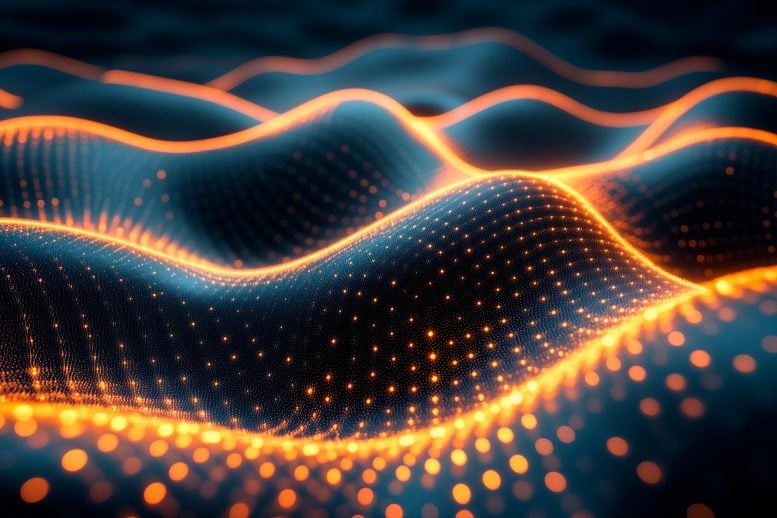
Through experiments at the BER II neutron source and its High-Field Magnet, researchers have discovered new quantum states in the material SrCu2(BO3)2 under extreme magnetic fields. Identifying a spin-nematic phase that resembles the condensation of bosonic Cooper pairs, this study emphasizes the utility of neutron scattering in exploring unknown aspects of quantum materials, offering insights into complex many-body systems under conditions of strong frustration. Credit: SciTechDaily.com
New states of order can arise in quantum magnetic materials under magnetic fields. An international team has now gained new insights into these special states of matter through experiments at the Berlin neutron source BER II and its High-Field Magnet. BER II served science until the end of 2019 and has since been shut down. Results from data at BER II are still being published.
“We measured in November 2019, our experiment was one of the very last ones performed on the High-Field Magnet at BER,” Dr. Ellen Fogh points out. The physicist leads a team at the Laboratory of Quantum Magnetism at the Ecole Polytechnique Fédérale de Lausanne (EPFL) and has now published intriguing new insights in quantum materials obtained in collaboration with colleagues from Japan, Qatar, and Switzerland.
“Many effects in matter only become visible under extreme conditions, i.e. temperatures close to zero kelvin and magnetic fields above 20 Tesla,” she says. The perfect place to examine these effects was at the neutron source BER II, where an HZB team has set up a unique High-Field Magnet, reaching up to nearly 26 Teslas.
Schematic illustration of a 2D spin-lattice with orthogonal orientation of spin pairs. Bound pair of magnons are represented by the red/blue and green pinwheels. Credit: EPFL
Challenges in Data Interpretation
“The evaluation took a lot of time,” she says. This is because the neutron scattering data do not automatically provide a picture, but have to be interpreted. This requires convincing theoretical models. “We played a game of ping-pong with a team of theorists, but now we have some very interesting results.”
Fogh and team analyzed samples of SrCu2(BO3)2 — a model system for ideal frustration in a two-dimensional (2D) spin system. It consists of spin pairs that are arranged orthogonally on a square lattice and influence each other in different ways. This “ideally frustrated” geometry leads to many unconventional effects, which are described in terms of entangled quantum states and their excitations (magnons). Magnetic order in such materials is usually described as Bose-Einstein Condensation (BEC) of magnons.
Physicists in front of the High-Field Magnet at BER II during one of the last measurements. Some of the team members did not contribute to this paper (ambient pressure) but to a next publication on the behaviour of the model system under high pressure. Names from left to right: Koji Munakata, Kazuhisa Kakurai, Gaétan Giriat, Luc Testa, Jana Pásztorová, Ellen Fogh and Henrik M. Rønnow. Credit: EPFL/HZB
“We wanted to find out whether this magnon BEC also occurs in our model system at high magnetic fields, or whether there is an alternative mechanism,” says Fogh. The neutron scattering experiment at the High-Field Magnet of BER II was ideally suited for this purpose: “We were able to measure spin excitations of SrCu2(BO3)2 up to 25.9 T and reproduce the experimental spectra with high accuracy using theoretical models.” The experiments took place at ambient pressure and temperatures close to absolute zero, at 200 millikelvin.
The analysis and interpretation of the measurement data shows that a spin-nematic phase is formed under these extremely high magnetic fields. In place of single magnons, it is bound pairs of magnons condensing in this phase. There is even an analogy to superconductivity, suggesting that the spin-nematic phase in SrCu2(BO3)2 is best understood as a condensate of bosonic Cooper pairs.
The results show that neutron scattering experiments in extremely high magnetic fields can be used to explore previously unknown regions of matter, in particular correlated phases of many-body systems. “Under conditions of strong frustration and controlled extremes, many new states and orders can still be found,” concludes Fogh.
Reference: “Field-induced bound-state condensation and spin-nematic phase in SrCu2(BO3)2 revealed by neutron scattering up to 25.9 T” by Ellen Fogh, Mithilesh Nayak, Oleksandr Prokhnenko, Maciej Bartkowiak, Koji Munakata, Jian-Rui Soh, Alexandra A. Turrini, Mohamed E. Zayed, Ekaterina Pomjakushina, Hiroshi Kageyama, Hiroyuki Nojiri, Kazuhisa Kakurai, Bruce Normand, Frédéric Mila and Henrik M. Rønnow, 10 January 2024, Nature Communications.
DOI: 10.1038/s41467-023-44115-z
>>> Read full article>>>
Copyright for syndicated content belongs to the linked Source : SciTechDaily – https://scitechdaily.com/physicists-have-uncovered-a-new-spin-phase-in-quantum-materials/